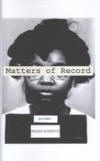Matters of Record
The nineteen poems that make up Megan Roberts’s chapbook, Matters of Record, combine to offer readers a compelling narrative portrait of the lives of women and girls executed in the United States across a wide span of time (the earliest execution takes place in 1860, while the most recent is dated 2005). The book opens with an epigraph taken from Jean-Paul Sartre: “I say a murder is abstract. You pull the trigger and after that you do not understand anything that happens.” And in most of these poems, the murder itself does indeed remain abstract. Even the more graphically violent pieces, such as the eponymous “Matters of Record,” which describes how a young girl was “seven when whipped / to death and the scars / was tortured with a red hot poker,” does so with a curious sense of remove. The violence occurs in the passive voice, and the poem focuses on the young victim rather than on the perpetrator of the violence.
The nineteen poems that make up Megan Roberts’s chapbook, Matters of Record, combine to offer readers a compelling narrative portrait of the lives of women and girls executed in the United States across a wide span of time (the earliest execution takes place in 1860, while the most recent is dated 2005). The book opens with an epigraph taken from Jean-Paul Sartre: “I say a murder is abstract. You pull the trigger and after that you do not understand anything that happens.” And in most of these poems, the murder itself does indeed remain abstract. Even the more graphically violent pieces, such as the eponymous “Matters of Record,” which describes how a young girl was “seven when whipped / to death and the scars / was tortured with a red hot poker,” does so with a curious sense of remove. The violence occurs in the passive voice, and the poem focuses on the young victim rather than on the perpetrator of the violence.
This is not to say that the poems themselves are abstract; on the contrary, they are largely narrative, as they seek to illuminate the personhood—or, at times, the motivations—of these executed women. The book opens with the last meal request of a condemned woman—“Karla wrote her request for a peach, / a banana and a salad”—and concludes with the hanging of a different condemned woman, as witnessed by a small girl, taking us as readers from the perpetrator’s final moments to the effect the death will have on the viewing public. Fifteen of the poems speak directly to or about specific women; fourteen of these do so by naming the executed person in epigraph form beneath the title of the poem, while one more, “Quiet Execution,” includes no epigraph but names the executed person by first and last name within the body of the poem itself.
Taken on their own, the poems are at times quite moving, as they offer readers precise snapshots, sometimes from the perspective of the women themselves, and sometimes from the perspective of their victims or the viewers attending their executions, as in the last poem in the collection, “Looking On.” These poems are quite good individually, and at times the arrangement allows the collected poems to echo each other.
For example, “To All the Daughters” addresses the children of incarcerated women, and a few pages later, the child narrator in “Looking On” is positioned so that she is waiting to view a hanging, recalling the girls a few pages earlier, “Little Mary Janes touching the curb, still waiting / for a car that never comes around the corner, / never shows up again.” Likewise, we are reminded of the last meal featured in the collection’s first poem when we arrive much later at the lines in “Quiet Execution,” which addresses Helen Fowler, and tells her that when “you died, you ate the same meal / as all of Sing Sing. You didn’t leave / last words; your name didn’t touch a single ear, Helen.”
However, the collection chooses not to take a political stance and makes no explicit statement as to the state of justice, or of womanhood, which seems surprising, given that the poems are so tightly focused around incarcerated, executed women. To limit a collection to such a specific demographic—particularly one that is positioned as historically marginalized in not one but two ways, as women and as products of the American justice system—and to leave this unaddressed will likely leave some readers unsatisfied. Let us return, then, to the words from Sartre that frame the collection, which in a sense seem to discharge the collection itself from the responsibility of larger understanding. Although the women who populate Matters of Record’s pages may not understand anything that happens after they pull the trigger, then at least they appear here in a portrayal that is sensitively and vividly constructed, so that we as readers may hope to begin to.





